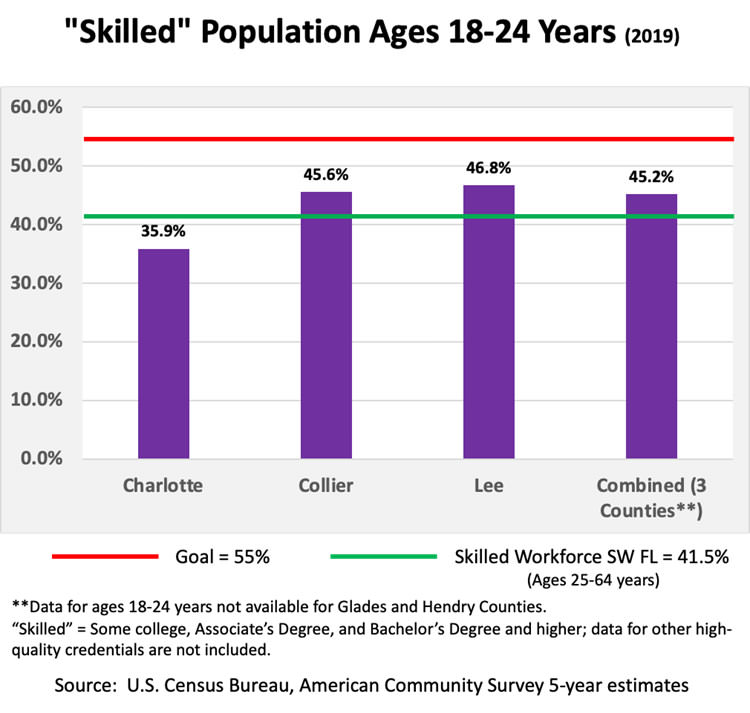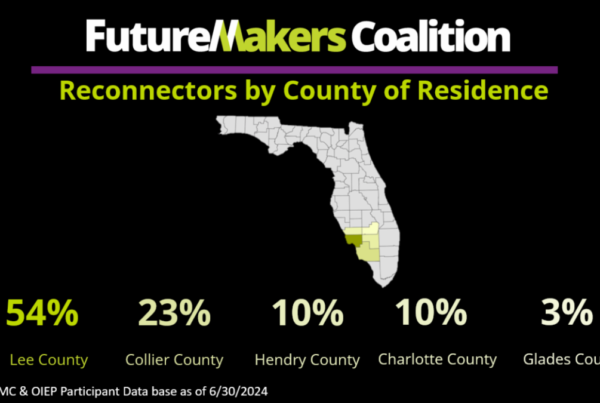
The Southwest Florida Educational and Workforce Outcomes Report 2020-2021 stated that the region’s skilled workforce reached 41.5 percent of the total working age population (ages 25-64 years) in 2019, representing a small but steady increase from 39.0 percent in 2013. This raises one question: how do the region’s younger workers ages 18-24 years compare to this statistic? These workers are too young to be included in the definition of “working age population” (and therefore, are not included in the skilled workforce calculation), but may have attained a high-quality credential that would fit the definition of “skilled workforce”. A preliminary look at the available 2019 U.S. Census Bureau data suggest that there may be positive news.
Looking at the U.S. Census Bureau, American Community Survey 5-year estimates for Charlotte, Collier, and Lee counties only, the aggregate data in the chart below suggests that 45.2 percent of the working age population ages 18-24 years may be classified as “skilled”. It is important to note that the economic analysts from Florida Gulf Coast University extrapolated data for Glades and Hendry counties, as well as applied a two-part definition of “skilled workforce” for the Southwest Florida Educational and Workforce Outcomes Report 2020-2021.[i] Therefore, the percentages for the two workforce age groups presented in the chart are not directly comparable. Nonetheless, this partial information for the younger workers who may fit the skilled workforce definition in the near future requires thoughtful consideration.
[i] Skilled workforce in the Southwest Florida Educational and Workforce Outcomes Report 2020-2021 is measured in two parts. The first part is obtaining the percent of the working population with at least an associate’s degree directly from the U.S. Census Bureau American Community Survey 5-year estimates. The second part uses a study from the Georgetown Center on Education and the Workforce that identifies the portion of the working population that does not hold an associate’s degree, but instead hold some form of high-quality credential. The Georgetown study states that high school graduates receive a 20 percent wage premium from possessing a certificate. Therefore, the annual Outcomes Report defines a high-quality credential holder as an individual with “some college” education experience and is making at least 20 percent higher than the median income of a high school graduate in their county.
The annual Outcomes Report further states that approximately 83,000 more skilled working age adults (ages 25-64 years) would have been needed in 2019 to achieve FutureMaker Coalition’s goal of a 55 percent skilled workforce. Looking ahead, how could the region’s younger workers (ages 18-24 years) contribute to reaching our 55 percent goal? According to the U.S. Census Bureau, American Community Survey 5-year estimates from 2019:
- 38,543 of the region’s younger workers may already be considered “skilled”. How do we keep them in Southwest Florida?
- g. improve access to affordable housing and child care options, expand “stop out” programs, improve/expand regional economic diversity, increase opportunities for career advancement.
- 30,506 of the younger workers hold a high school diploma (including GED). How do we make it easier for them to attain a high-quality credential (and keep them in Southwest Florida)?
- g. in addition to the items above, expand remote learning, increase micro-credential opportunities and access to financial aid, improve business partnerships, increase access to career counseling.
- 16,177 of the younger workers have less than a high school credential. How do we increase the graduation rate (or make it easier to attain a GED) and set them on a path to attain a high-quality credential?
- g. improve access to necessary classes, GED test preparation workshops, and career counseling, improve business partnerships.
Luckily, FutureMaker Coalition’s incredible network of professionals from the region’s educational institutions, not-for-profit organizations, and businesses have already been working on these issues. The Regional Action Teams have entered 2022 with enthusiasm and a clear focus on achieving the Coalition’s goals!
[1] Skilled workforce in the Southwest Florida Educational and Workforce Outcomes Report 2020-2021 is measured in two parts. The first part is obtaining the percent of the working population with at least an associate’s degree directly from the U.S. Census Bureau American Community Survey 5-year estimates. The second part uses a study from the Georgetown Center on Education and the Workforce that identifies the portion of the working population that does not hold an associate’s degree, but instead hold some form of high-quality credential. The Georgetown study states that high school graduates receive a 20 percent wage premium from possessing a certificate. Therefore, the annual Outcomes Report defines a high-quality credential holder as an individual with “some college” education experience and is making at least 20 percent higher than the median income of a high school graduate in their county.




























